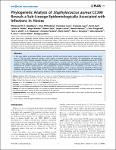Phylogenetic Analysis of Staphylococcus aureus CC398 Reveals a Sub-Lineage Epidemiologically Associated with Infections in Horses
Abdelbary, Mohamed M. H.
Wittenberg, Anne
Cuny, Christiane
Layer, Franziska
Kurt, Kevin
Wieler, Lothar H.
Walther, Birgit
Skov, Robert
Larsen, Jesper
Hasman, Henrik
Fitzgerald, J. Ross
Smith, Tara C.
Wagenaar, J. A.
Pantosti, Annalisa
Hallin, Marie
Struelens, Marc J.
Edwards, Giles
Böse, R.
Nübel, Ulrich
Witte, Wolfgang
In the early 2000s, a particular MRSA clonal complex (CC398) was found mainly in pigs and pig farmers in Europe. Since then, CC398 has been detected among a wide variety of animal species worldwide. We investigated the population structure of CC398 through mutation discovery at 97 genetic housekeeping loci, which are distributed along the CC398 chromosome within 195 CC398 isolates, collected from various countries and host species, including humans. Most of the isolates in this collection were received from collaborating microbiologists, who had preserved them over years. We discovered 96 bi-allelic polymorphisms, and phylogenetic analyses revealed that an epidemic sub-clone within CC398 (dubbed ‘clade (C)’) has spread within and between equine hospitals, where it causes nosocomial infections in horses and colonises the personnel. While clade (C) was strongly associated with S. aureus from horses in veterinary-care settings (p = 2×10−7), it remained extremely rare among S. aureus isolates from human infections.
Dateien zu dieser Publikation
Keine Lizenzangabe
Verwandte Publikationen
Anzeige der Publikationen mit ähnlichem Titel, Autor, Urheber und Thema.
-
2007-05-25ZeitschriftenartikelFepA- and TonB-dependent bacteriophage H8: receptor binding and genomic sequence. Rabsch, Wolfgang; Ma, Li; Wiley, Graham; Najar, Fares Z.; Kaserer, Wallace; Schuerch, Daniel W.; Klebba, Joseph E.; Roe, Bruce A.; Gomez, Jenny A. Laverde; Schallmey, Marcus; Newton, Salete M. C.; Klebba, Phillip E.H8 is derived from a collection of Salmonella enterica serotype Enteritidis bacteriophage. Its morphology and genomic structure closely resemble those of bacteriophage T5 in the family Siphoviridae. H8 infected S. enterica ...
-
2005-06-20ZeitschriftenartikelViral promoters can initiate expression of toxin genes introduced into Escherichia coli Lewin, Astrid; Mayer, Martin; Chusainow, Janet; Jacob, Daniela; Appel, BerndBackground: The expression of recombinant proteins in eukaryotic cells requires the fusion of the coding region to a promoter functional in the eukaryotic cell line. Viral promoters are very often used for this purpose. ...
-
2013-08-08ZeitschriftenartikelCytomegalovirus Downregulates IRE1 to Repress the Unfolded Protein Response Stahl, Sebastian; Burkhart, Julia M.; Hinte, Florian; Tirosh, Boaz; Mohr, Hermine; Zahedi, René P.; Sickmann, Albert; Ruzsics, Zsolt; Budt, Matthias; Brune, WolframDuring viral infection, a massive demand for viral glycoproteins can overwhelm the capacity of the protein folding and quality control machinery, leading to an accumulation of unfolded proteins in the endoplasmic reticulum ...

